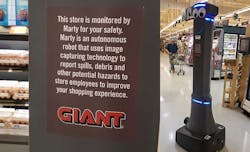As Retail Retools, Robots Are Coming to a Store Near You
This is the first in a series of stories examining how artificial intelligence is disrupting industries.
Marty isn’t a giant robot. But he’s a robot that resides at Giant, and he’s likely coming to a grocery store near you – if he’s not roaming the produce aisles already.
Marty is a tall gray robot with googly eyes that wanders the store, monitoring the state of the floor so it can report spills and other hazards to employees. Ahold Delhaize, the parent company of Giant Food Stores, is planning to deploy more than 500 robots across its stores.
Through the years there have been many movies, cartoons, and stories about robots that can move and act without human interaction, carrying out their tasks to make human lives easier. From Rosie (The Jetsons) to Sonny (I, Robot), humanity has long been fascinated with the idea of having robots to take some of the weight off its collective shoulders.
With recent advances in technology, artificial intelligence and robotics are no longer limited to science fiction or popular media. These tools are changing the way consumers and business owners look at nearly every industry, including retail.
Retail giants are already starting to roll out artificial intelligence and robotics to help improve customer experiences and take over some of the tedious tasks that accompany running a retail storefront.
Retail AI and Robotics in Action
How is the retail industry implementing AI and other robotic helpers? And how will this change the consumer’s shopping experience heading into the future?
- Walmart is also joining the robotics revolution, planning to bring robots to 5,000 of its stores. The pilot program will include 1,110 locations where robots will eliminate lower-level service jobs by scrubbing floors, unloading trucks, scanning inventory, and more.
- Amazon has 45,000 robots in its warehouses and distribution centers, helping order pickers complete their job more efficiently. Amazon didn’t outsource their robotics, however — the retail giant purchased a robotics startup to handle all the logistics.
- Lowes introduced a LowesBot in a San Francisco store in 2016 which could answer customer questions and even lead them to the exact aisle and shelf where their desired product was located.
- In Japan, Softbank has Pepper – a humanoid robot that can chat with customers, play music, dance or take selfies with them. While it has a practical use, the novelty of the robot has increased foot traffic in these Softbank locations by 70 percent while Pepper was there, and the company is trying to bring it to U.S. markets.
This is just a small sampling of the potential applications for robotics in the retail and grocery industries. What are the benefits of adopting this technology for both consumers and businesses?
Consumer Benefits of AI and Robotics in Retail
How will AI and robotics in retail benefit customers?
In some instances, it could provide a better shopping experience. WalMart recently filed a patent for a robot that uses facial recognition technology to determine if a shopper has had a poor experience in their store. By analyzing the shopper’s facial expressions, the AI can determine if they’ve enjoyed their shopping experience or are upset. If the latter, the robot will alert human staff to talk to the customer and attempt to rectify the situation.
Many of these robots, like Tally which calls Schnuck Markets home, can make the customer’s experience better by ensuring that the shelves are clean, stocked and organized. Tally can even update prices as they change, or correct mispriced items on the shelf without ever needing to involve a human worker.
The goal of AI and robotics in retail is to provide a better shopping experience for consumers, even though robots will never take the place of human employees for customer service and problem-solving.
The overall goal of AI and robotics in retail is to provide a better shopping experience for consumers, even though robots will never take the place of human employees for things like customer service and problem-solving. Most customers prefer to speak to a live person when they’re having a problem or have a concern that they’d like to express, limiting the usefulness of AI systems and retail robots.
Commercial Benefits of AI and Robotics in Retail
Consumers aren’t the only ones who will benefit from the implementation of AI and robotics in the retail industry. Inventory management will become a key point for these retail software systems. More than 83% of companies surveyed said that they lose more revenue to inaccurate inventories than they do to theft and shrinkage.
Many of the robots listed above are designed to help monitor inventory levels automatically as they explore the store. When a product is out of stock, a quick scan from the robot could add the product to the next truck order or inform an employee that they need to pull the product from the back room and move it to the sales floor. As the technology continues to advance, robots might be able to skip the human element entirely, moving products from storage to the sales floor autonomously as they sell.
Pepper is a robot from Softbank designed to help retail customers locate items, but also attract foot traffic from passers-by, as with these two models in a display window in a Softbank store in the Harajuku section of Tokyo. (Photo: Rich Miller)
Upgrades in the software are changing the way both retail companies and their suppliers are facing the ever-shifting industry. The apparel industry, for example, is one that is tied closely with retail and many aspects of this industry have started to make the shift toward general automation.
Seventy three percent of companies surveyed have experienced problems with inventory forecasting, so they almost always end up with too much or too little product to meet consumer demands. Artificial intelligence and machine learning in the retail industry can help prevent or at least mitigate this problem by using past data to predict shifts in demand. Machine learning and AI programs can sort through years of data in a fraction of the time that it would take for human analysts to do the same, detecting patterns and making predictions based on what has happened in the past. The more information the system has to work with, the more accurate these predictions will become.
Workforce Impacts of AI and Robotics in Retail
This push toward robotics and artificial intelligence in the retail industry might seem like a step in the right direction, but it doesn’t come without a cost. Robots will take jobs from many entry-level employees in the industry, eliminating positions like stockers or janitorial staff.
This isn’t to say that robots will completely replace entry-level employees, though even if they do it might not be a bad thing for workers. First, AI and human workers will likely be integrated side by side, especially to start, because these new technologies will need a human overseer before they can become entirely autonomous.
Removing the need for human workers in low-skilled positions may also give these individuals the opportunity to learn new skills and advance in their current careers rather than spending years or decades in an entry-level position. Life-long learning will become the norm, and people will likely continue to seek out educational opportunities throughout their careers because they won’t be limited to a single position or field.
Looking Toward the Future
While Wal-Mart, Lowes, Amazon and others have started rolling out robotics and AI in the retail industry, commercial properties are a long way off from seeing this technology become mainstream. Some of these ideas, such as Wal-Mart’s patent for facial recognition technology, might fall by the wayside or fail entirely. Robotics and AI will continue to shape the retail industry — and industry in general — for decades to come.
Robots may never replace cashiers or managers, but consumers might start seeing robotic assistants stocking shelves or scrubbing the floors sooner they could imagine. The sector is changing, and robots and AI are just the first steps toward a more customer-centric retail industry.

